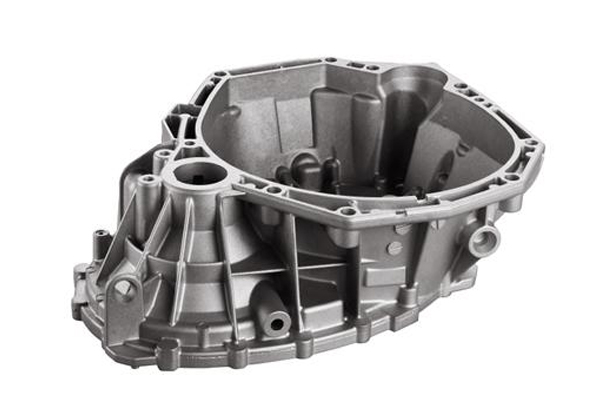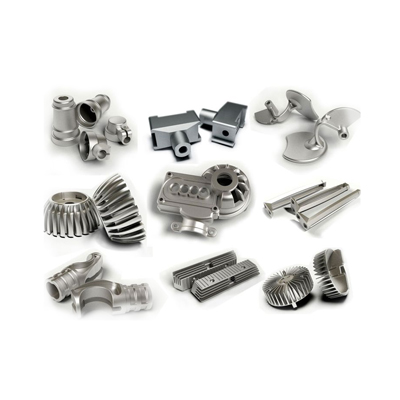Exploring the Benefits of Using Aluminum Castings in Modern Production
Aluminum castings have become increasingly relevant in modern-day production because of their one-of-a-kind residential or commercial properties. The lightweight nature of aluminum enables more intricate styles, particularly advantageous in markets like auto and aerospace. Its rust resistance extends item lifespan, while cost-effectiveness boosts production effectiveness. These benefits invite a closer assessment of aluminum's role in different applications and its influence on layout flexibility and sustainability in making processes.
Light-weight Features and Their Influence On Design
The lightweight residential or commercial properties of aluminum castings substantially influence contemporary style methods throughout different markets. Developers and engineers often focus on weight reduction in their jobs to enhance efficiency and performance. This particular allows for the creation of complex forms and designs that would be testing with larger materials. In markets such as auto and aerospace, where every gram counts, aluminum castings add to sustain efficiency and lowered emissions. Additionally, the ease of producing procedures like die casting enables the production of complex geometries, causing innovative product layouts. The ability to stabilize stamina and weight makes aluminum an appealing choice for manufacturers looking to optimize product capability while minimizing manufacturing prices. As markets continue to advance, the adoption of aluminum castings is likely to increase, fostering new chances for design creativity and design improvements. Generally, the light-weight nature of aluminum is a crucial consider shaping contemporary manufacturing practices.

Superior Corrosion Resistance for Longevity
Numerous materials endure from degradation over time, aluminum castings stand out for their premium corrosion resistance, substantially boosting the durability of items. This resistance is largely credited to the all-natural formation of a safety oxide layer on the aluminum surface, which hinders more oxidation and prevents rusting. Unlike steel or iron, aluminum does not wear away easily when revealed to dampness or different chemicals, making it an optimal option for applications in rough settings.
On top of that, aluminum castings maintain structural stability over expanded durations, decreasing the requirement for constant replacements. This reliability is critical in fields such as vehicle, aerospace, and marine, where element failure might bring about considerable security concerns. By selecting aluminum castings, producers can assure that their products not just endure the test of time but also do constantly under tough problems, ultimately benefiting both manufacturers and end-users with boosted longevity and fewer upkeep needs.
Cost-Effectiveness in Production
Cost-effectiveness in aluminum casting production is driven by numerous key factors. Decreased material waste adds to reduce production expenses, while quick manufacturing times enhance general performance. These aspects collectively position aluminum castings as a viable option for producers seeking to enhance their operations.
Lowered Product Waste
Reducing material waste in aluminum casting not just improves sustainability however likewise significantly decreases manufacturing costs. Efficient use raw materials is important in modern-day manufacturing, where reducing waste can bring about considerable financial savings. Aluminum casting procedures allow for intricate designs with specific specifications, which helps to maximize material usage and decrease unwanted. Methods such as near-net form casting better restrict the quantity of scrap generated during production. Additionally, the recyclability of aluminum contributes to a decrease in waste, as leftover products can be melted and recycled in future applications. By adopting aluminum casting methods, suppliers can achieve not just a more environmentally friendly procedure however additionally a structured manufacturing process that makes best use of source performance and decreases general material prices.
Lower Manufacturing Expenses

Rapid Manufacturing Times
While many elements add to the overall effectiveness of manufacturing procedures, rapid manufacturing times attract attention as a significant advantage of aluminum casting. This technique enables the rapid production of components, significantly decreasing preparations. The capability to produce intricate shapes with high accuracy implies that producers can rapidly react to market demands and range manufacturing as needed. Furthermore, aluminum's positive thermal residential or commercial properties allow faster cooling prices, additionally expediting the total casting procedure. Subsequently, shorter manufacturing cycles lead to enhanced stock turn over and reduced functional expenses. By reducing delays and enhancing throughput, aluminum casting supports a much more agile production atmosphere, ultimately adding to raised competition in the industry.
Style Flexibility and Facility Geometries
Aluminum castings provide amazing design adaptability, enabling the creation of complex geometries that would certainly be testing with other materials. This ability allows makers to generate lightweight architectural services that boost total efficiency and effectiveness. look at this site Furthermore, the fast prototyping capacity of aluminum castings speeds up the advancement process, promoting development in layout.
Intricate Layout Capabilities

Lightweight Architectural Solutions
Manufacturers progressively leverage aluminum castings to deliver light-weight structural options that do not compromise on stamina or sturdiness. The integral properties of aluminum, including its low thickness and high strength-to-weight proportion, make it an optimal choice for applications where weight reduction is vital. This light-weight characteristic facilitates design flexibility, enabling designers to create complex geometries that standard products might not accommodate. In addition, aluminum castings can be tailored to particular performance requirements, boosting functionality without including extreme weight. This versatility enables the manufacturing of complex components for numerous markets, such as aerospace and automobile, where efficiency and efficiency are critical. Overall, aluminum castings play an essential duty beforehand modern production through cutting-edge structural layouts.
Fast Prototyping Potential
Fast prototyping has become a game-changer in contemporary manufacturing, especially when it comes to make versatility and the capacity to produce intricate geometries. Aluminum castings facilitate this technology, permitting engineers to create elaborate designs that would certainly be difficult or difficult with traditional methods. The lightweight nature of aluminum improves the simplicity of manipulation during the prototyping stage, enabling fast iterations and alterations. The material's outstanding thermal conductivity and corrosion resistance contribute to the longevity of prototypes, making them suitable for testing in real-world problems. Because of this, producers can increase product development cycles, decrease expenses, and enhance technology. Ultimately, the assimilation of aluminum castings into rapid prototyping processes supports the next page creation of advanced, high-performance elements customized to details applications.
Enhanced Thermal and Electrical Conductivity
While aluminum castings are renowned for their light-weight residential properties, their boosted thermal and electrical conductivity likewise plays an important role in modern manufacturing. This particular makes aluminum an ideal option for applications needing efficient warm dissipation and electric efficiency. Parts in electronics benefit from aluminum's capacity to properly transfer warmth, consequently lessening the risk of getting too hot and lengthening device life-span. In vehicle and aerospace markets, aluminum castings add to boosted thermal management systems, advertising energy efficiency.
Moreover, the high electrical conductivity of aluminum enables its extensive use in electric components, such as ports and bus bars. This feature not only reduces power loss throughout transmission yet also enhances total efficiency. The mix of these properties placements aluminum castings as a recommended material in countless applications, driving development and performance in producing processes across numerous industries.
Sustainability and Environmental Benefits
Aluminum castings use considerable sustainability and ecological benefits, lining up with the expanding emphasis on eco-friendly production techniques. One of the key advantages of aluminum is its recyclability; as much as 95% of aluminum can be reused without losing high quality. This procedure consumes only a portion of the power needed for primary production, substantially decreasing greenhouse gas exhausts.
Additionally, aluminum is lightweight, which adds to power efficiency in transport and item use. Its longevity and resistance to rust expand the lifespan of products, lessening waste and the demand for frequent replacements. Additionally, using aluminum castings can lead to much more effective production procedures, as they often need less energy and product contrasted to typical approaches.
Applications Throughout Numerous Industries
As sectors significantly look for flexible products for ingenious applications, aluminum castings have actually become a prominent choice across various markets. In the vehicle market, lightweight aluminum castings add to boosted fuel efficiency and efficiency, while in aerospace, they supply stamina without endangering weight, essential for airplane design. The consumer electronic devices sector gain from aluminum's excellent thermal conductivity, making it optimal for warmth sinks and enclosures. Furthermore, the building and construction market utilizes aluminum castings for home window structures, roof parts, and architectural components due to their sturdiness and resistance to deterioration. In addition, the medical tools market counts on aluminum castings for producing exact, light-weight elements that fulfill rigid health standards. These diverse applications highlight the adaptability of aluminum castings, making them a preferred product for producers intending to innovate and enhance item efficiency throughout numerous areas.
Frequently Asked Concerns
Just How Are Aluminum Castings Produced in the Production Process?
Aluminum castings are produced with a procedure entailing melting aluminum, pouring it right into mold and mildews, and permitting it to solidify. Aluminum Casting. This method enables the production of intricate shapes and specific measurements required in numerous applications
What Safety Steps Are Required When Collaborating With Aluminum Castings?
When working with aluminum castings, crucial precaution include wearing safety equipment, making sure appropriate ventilation, implementing fire safety procedures, and preserving equipment to stop accidents, thereby securing workers versus possible threats linked with the casting procedure.
Can Aluminum Castings Be Recycled, and Just how Is This Done?
Aluminum castings can undoubtedly be reused properly. The procedure involves accumulating scrap aluminum, thawing it down in heaters, and after that changing it right into brand-new products, therefore preserving sources and decreasing environmental effect in manufacturing.
What Are the Typical Issues in Aluminum Castings and Just How to Stay clear of Them?
Usual issues in aluminum castings include porosity, shrinkage, and surface area flaws. To avoid these problems, correct mold and mildew layout, temperature control, and material choice are essential, making sure suitable casting conditions and reducing the likelihood of defects.
Just How Do Aluminum Castings Compare to Other Materials in Terms of Toughness?
Aluminum castings show favorable strength-to-weight proportions contrasted to lots of products - Aluminum Casting. While typically much less strong than steel, they exceed plastics and provide sufficient toughness for various applications, making them a flexible selection in manufacturing processes